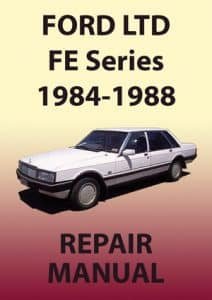FE LTD DIY Repairs
Ford FE LTD- 1984-1988
Released in October 1984, the FE LTD was available only with the alloy head 4.1-litre six-cylinder engine, with multi-point fuel injection as standard. A V8 was no longer an option. The six cylinder had been greatly improved over the years and gave the big car strong straight line performance for safe overtaking. Though it follows the same general styling theme as its predecessor, the FE LTD looks very attractive due to the aggressive chromed finish at the front of the body, that bold look carries across to the design of the alloys wheels.
The FE Ford LTD was road tested as part of a comparison with some European luxury cars. The Australian Ford fared well overall, particularly from an engine performance point of view. It did, however, get some criticism for its handling which was described as having, grip but little finesse.
The FE model continued until mid-1988. The vertical bar grille now filled up all the space between the headlights and there were a few other minor styling changes such as the turn indicators being moved to the bumper. Big rear lights in a square tail add a lot to the prestige of the most expensive Australian Ford. The rear seat featured dual head restraints to protect rear seat occupants in the event of a tail-end crash.
Inside was a different story. Velour trim became available and a premium sound system was added. There were two new standard features to add to the extensive list which included air conditioning, central locking, electric windows and power steering. These were cruise control and a trip computer.
Ford Australia excelled itself with the complexity of the dash arrangement. A plethora of buttons could cause confusion according to road testers of the time. For example it took ten controls just to operate the ventilation system! In common with other car makers of the era Ford Australia got caught up in the craze of digital dashboards. In the LTD it had a numerical readout speedometer, with the minor instruments using vertical strips.
Ford’s Electronic Engine Control System Mark 4 (EEC4) was a sophisticated unit. In conjunction with electronic fuel injection it gave the six-cylinder engine more power and better economy than ever before. Some car makers struggled to make their engines work well on recently introduced unleaded petrol, but the Ford engines operated properly from the start. A limited slip differential was fitted as standard with the EFI/EEC4 engine.

